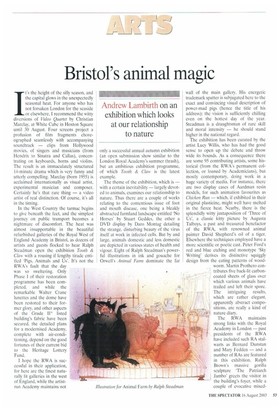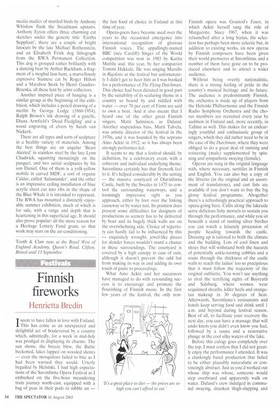Bristol's animal magic
Andrew Lambirth on an exhibition which looks at our relationship to nature 1 t's the height of the silly season, and the capital glows in the unexpectedly seasonal heat. For anyone who has not forsaken London for the seaside or elsewhere, I recommend the witty diversions of Video Quartet by Christian Marclay, at White Cube in Hoxton Square until 30 August. Four screens project a profusion of film fragments choreographed seamlessly with accompanying soundtrack — clips from Hollywood movies, of singers and musicians (from Hendrix to Sinatra and Callas), concentrating on keyboards, horns and violins. The result is an immaculately structured 14-minute drama which is very funny and utterly compelling. Marciay (born 1955) is acclaimed internationally as visual artist, experimental musician and composer. Certainly he's that rare thing — a video artist of real distinction. Of course, it's all in the timing.
In the West Country the tarmac begins to give beneath the feet, and the simplest journey on public transport becomes a nightmare of discomfort. The heat was almost insupportable in the beautiful refurbished galleries of the Royal West of England Academy in Bristol, as dozens of artists and guests flocked to hear Ralph Steadman open the exhibition Tooth & Claw with a rousing if lengthy tirade entitled 'Pigs, Animals and Us'. It's not the RWA's fault that the day was so sweltering. Only Phase I of their restoration programme has been completed, and while the i,remarkable Walter Crane lunettes and the dome have been restored to their former glory, and other aspects of the Grade II* listed building's fabric have been secured, the detailed plans for a modernised Academy, complete with air-conditioning, depend on the good fortunes of their current bid to the Heritage Lottery Fund.
I hope the RWA is successful in their application, for here are the finest naturally lit galleries in the west of England, while the artistrun Academy maintains not only a successful annual autumn exhibition (an open submission show similar to the London Royal Academy's summer thrash), but an ambitious exhibition programme, of which Tooth & Claw is the latest example.
The theme of the exhibition, which is — with a certain inevitability — largely devoted to animals, examines our relationship to nature. Thus there are a couple of works relating to the contentious issue of foot and mouth disease, one being a bleakly abstracted farmland landscape entitled 'No Horses' by Stuart Geddes, the other a DVD display by Daro Montag detailing the strange, disturbing beauty of the virus itself at work in infected cells. But by and large, animals domestic and less domestic are depicted in various states of health and vigour. Eight of Ralph Steadman's powerful illustrations in ink and gouache for Orwell's Animal Farm dominate the far wall of the main gallery. His energetic trademark spatter is subjugated here to the exact and convincing visual description of power-mad pigs (hence the title of his address); the vision is sufficiently chilling even on the hottest day of the year. Steadman is a draughtsman of rare skill and moral intensity — he should stand higher in the national regard.
The exhibition has been curated by the artist Lucy Willis, who has had the good sense to open up the debate and throw wide its bounds. As a consequence there are some 95 contributing artists, some historical (from the RWA's permanent collection, or loaned by Academicians), but mostly contemporary, doing work in a huge variety of media. For instance, there are two display cases of Aardrnan resin models, for such animation favourites as Chicken Run — which, if exhibited in their original plasticine, might well have melted in the fierce heat. Nearby, there is the splendidly witty juxtaposition of 'Three of Us', a classic kitty picture by Augusta Talboys, a past and treasured benefactor of the RWA, with renowned animal painter David Shepherd's oil of a tiger. Elsewhere the techniques employed have a more scientific or poetic cast. Peter Ford's red and blue etching and monotype 'Sky Writing' derives its distinctive squiggly design from the eating patterns of woodworm. Martin Prothero contributes five back-lit carboncoated sheets of glass over which various animals have trailed and left their spore. The intriguing results, which are rather elegant, apparently abstract compositions, are really a kind of nature diary.
The RWA maintains strong links with the Royal Academy in London — past presidents of the RWA have included such RA stalwarts as Bernard Dunstan and Mary Fedden — and a number of RAs are featured in this exhibition. Ralph Brown's massive gorilla sculpture The Patriarch Jambo' greets the visitor in the building's foyer, while a couple of evocative mixed
media studies of startled birds by Anthony Whishawflank the Steadmans upstairs. Anthony Eyton offers three charming cat sketches under the generic title `Eartha Suppliant', there are a couple of bright linocuts by the late Michael Rothenstein, and an Elisabeth Frink dog lithograph from the RWA Permanent Collection. This dog is grouped rather brilliantly with a dancing bear by Arthur Rackham, a fragment of a moghul lion hunt, a marvellously expressive Siamese cat by Roger Hilton and a Marabou Stork by Henri GaudierBrzeska, all these lent by artist collectors.
Another inspired piece of hanging is a similar group at the beginning of the exhibition, which includes a pencil drawing of a merlin by George Lodge (1860-1954), Ralph Brown's ink drawing of a gazelle, Diana Armfield's 'Dead Fledgling' and a wood engraving of elvers by Sarah van Niekerk.
There are all types and sorts of sculpture in a healthy variety of materials. Among the best things are an angular 'Beast Alerted' in stainless steel by the late Lynn Chadwick, squatting menacingly on the parquet, and two aerial sculptures by his son Daniel. One of them is a yolk-yellow mobile in carved MDF, a sort of organic Calder, called 'Salamander', and the other is an impressive ceiling installation of blue acrylic sheet cut into ribs in the shape of the Blue Whale it is intended to represent. The RWA has mounted a distinctly enjoyable summer exhibition, much of which is for sale, with a range and depth that is heartening in this superficial age. It should also prove popular: all the more reason for a Heritage Lottery Fund grant, so that work may start on the air-conditioning.











































































 Previous page
Previous page